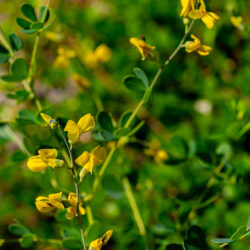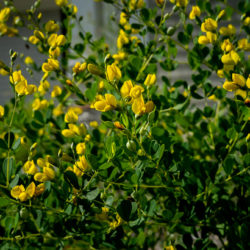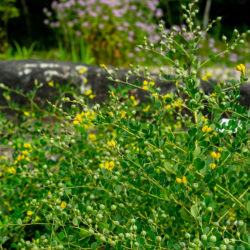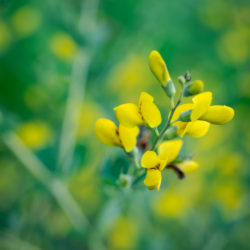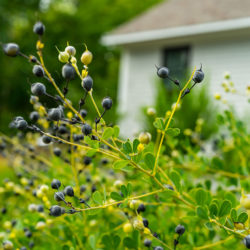Etymology
Baptisia is Greek for the verb baptizein, meaning to dye; tinctoria is Latin for dye.
Native Habitat
Sunny grasslands, fields, and open woodlands.
Garden Uses
Great for cottage, meadow, or native gardens. Naturalizes well in dry areas, with showy blooms later than most Baptisias. Tolerates most medium-dry to dry soils, but in very poor soils may need bacterial inoculant to successfully fix nitrogen. Light trimming after blooms keeps a rounded shape, and obviates need for staking, but removes developing seed pods, which could add some visual interest themselves.
Overview
A perennial, deciduous, shrub-like herb, native to sunny grasslands, fields, and open woodlands. As with other legumes, the roots are nitrogen-fixing when combined with specific (usually naturally-occurring) bacteria and can improve the health of other native plants within the community in following seasons. Not currently prevalent in most of Maine and may have been purposefully extirpated, but is still wide-spread in Massachusetts and very southern Maine.
Leaves and Stems
Compound, smooth (entire), gray-green, stalkless, clover-like (trifoliate) leaves, about 1 inch long, are alternate, growing one per node along the stem. Stems grow 2 to 3 ft tall, with a similar spread, to appear densely shrub-like. After blooming, they loosen outward and may benefit from support.
Flowers
Yellow, pea-like flowers, 1/2 inch long, grow in numerous, sparsely flowered, 4 - 5 inch long clusters at the ends of stems (terminal racemes), held above the foliage sphere. Each blossom is bilaterally symmetrical, with 10 stamen. Typical bloom time is in July.
Fruit/Seed
Seed pods, less than 1/2 inch in diameter, mature to black, and contain just one or two seeds each. They split open when ripe.
Animal Associates
Attracts pollinators, but deer resistant. Host plant to butterfly larvae, including wild indigo duskywing, clouded sulphuric, and rare frosted elfin butterfly.
Propagation
Establishes a deep and extensive root system and should not be disturbed once established. Stem cuttings may be rooted in early spring. Not as easy to propagate by seed as most Baptisias.
Ethnobotanical Uses
The plant is considered mildly poisonous if ingested, but in the past, it was used in a tea both to induce and stop vomiting. Also used as a rather weak blue dye.
Garden Location
Library Garden (see garden map)
Sources
Lady Bird Johnson Wildflower Center
Plant Profile by Kate O’Dell

